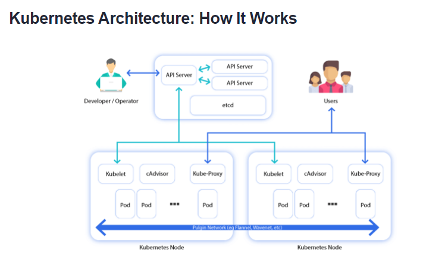Kubernetes
More and more, companies are concerned about having an IT infrastructure that can support advanced applications in terms of security, scalability, capacity and customization. The emergence of Kubernetes has been the natural response to these demands, allowing infrastructure teams to scale much more effectively.
Kubernetes is an open source system for managing container clusters. To do this, it provides tools to deploy applications and to scale them when necessary, managing changes to existing applications in containers, thus optimizing the use of underlying hardware under containers. It is designed to be extensible and resilient to failures, allowing application components to reboot and move throughout the system when needed.
Kubernetes was created by Google, a company that had been running similar systems to manage containers as part of its internal infrastructure for many years, until this open source project was launched in 2014. Today, it is an increasingly open source community. relevant, with engineers from the aforementioned company, Red Hat and many other organizations that want to contribute to the development of the system, such as the Linux Foundation, for example.
Structure and virtues of Kubernetes
The main organizational unit in Kubernetes has been called the “pod.” A pod is a group of containers that are managed as a set on the same machine or in a virtual machine, which are designed to be able to communicate with each other easily.

These pods can be organized into a service, which is a group of pods that works together and can be organized with a tag system, which allows metadata for objects such as pods to be stored in Kubernetes. All these parts can be orchestrated in a consistent and predictable way by means of an API (Application Programming Interface), predefined instructions or a command line.
Kubernetes has become the leading platform for containers. The most relevant cloud service providers support it, being the best option for organizations that are migrating more applications to the cloud. It provides a common framework to run distributed systems, so that development teams have a consistent and unalterable infrastructure from the start to production of each project.
The main attributes of Kubernetes are:
- Definition of service and process.
- Service discovery and load balancing.
- Storage orchestration.
- Resource management at the container level.
- Automated deployment and retraction.
- Container health management.
- Confidential information and configuration management.
Teams learning how to get the most out of Kubernetes reap significant benefits, such as availability, as its fault tolerance enables large-scale operations; autoscaling, determined by traffic and server load; and a vast ecosystem around CNI (Container Networking Interface) and CSI (Container Storage Interface), as well as built-in monitoring and logging tools.
Kubernetes was designed as a platform for the purpose of building an ecosystem of components and tools that make it easy to deploy, scale, and manage applications. Tags allow users to organize their resources as they wish, while annotations allow them to assign arbitrary information to a resource, in order to facilitate their workflows and make it easier for administrative tools to inspect health.
On the other hand, the Kubernetes Control Plane uses the same APIs that developers and end users use. Users can write their own controllers with their own APIs, from a command line tool. The described design allows other systems to be written on Kubernetes. This architecture supports most programming languages, such as Java and .NET, and is widely supported by the developer community. If an application has the ability to run in a container, it can run on Kubernetes as well.
The future
The consulting firm Gartner has estimated that more than 75% of global companies will run containerized applications by 2022, up from 30% in 2019. Kubernetes has become the standard for managing those containers. It has been indicated that the companies that will push the development of this system for the next few years will be Amazon Web Services, Google Cloud, and IBM Red Hat OpenShift, among others.
The irruption of Kubernetes has meant a modernization in the architecture. Going forward, future Kubernetes clusters are expected to contain a mix of containers running on dedicated machines, as well as crowding out serverless infrastructures. The how and when, as well as the details to get to that point, remain to be seen. What is clear is that the future success of Kubernetes is determined by the evolution of the serverless container infrastructure
